

Compact Muon Solenoid
LHC, CERN
| CMS-SUS-16-048 ; CERN-EP-2017-336 | ||
| Search for new physics in events with two soft oppositely charged leptons and missing transverse momentum in proton-proton collisions at $\sqrt{s} = $ 13 TeV | ||
| CMS Collaboration | ||
| 5 January 2018 | ||
| Phys. Lett. B 782 (2018) 440 | ||
| Abstract: A search is presented for new physics in events with two low-momentum, oppositely charged leptons (electrons or muons) and missing transverse momentum in proton-proton collisions at a centre-of-mass energy of 13 TeV. The data collected using the CMS detector at the LHC correspond to an integrated luminosity of 35.9 fb$^{-1}$. The observed event yields are consistent with the expectations from the standard model. The results are interpreted in terms of pair production of charginos and neutralinos ($\tilde{\chi}^{\pm}_1$ and $\tilde{\chi}^{0}_{2}$) with nearly degenerate masses, as expected in natural supersymmetry models with light higgsinos, as well as in terms of the pair production of top squarks ($\tilde{\mathrm{t}}$), when the lightest neutralino and the top squark have similar masses. At 95% confidence level, wino-like $\tilde{\chi}^{\pm}_1$/$\tilde{\chi}^{0}_{2}$ masses are excluded up to 230 GeV for a mass difference of 20 GeV relative to the lightest neutralino, a region constrained thus far only by the LEP experiments. For $\tilde{\mathrm{t}}$ pair production, top squark masses up to 450 GeV are excluded for a mass difference of 40 GeV relative to the lightest neutralino. | ||
| Links: e-print arXiv:1801.01846 [hep-ex] (PDF) ; CDS record ; inSPIRE record ; CADI line (restricted) ; | ||
| Figures & Tables | Summary | Additional Figures & Tables | References | CMS Publications |
|---|
|
Additional information on efficiencies needed for reinterpretation of these results are available
here. |
| Figures | |

png pdf |
Figure 1:
Production and decay of an electroweakino pair (left) and of a chargino-mediated $\tilde{\mathrm{t}} $ pair (right). |

png pdf |
Figure 1-a:
Production and decay of an electroweakino pair. |

png pdf |
Figure 1-b:
Production and decay of a chargino-mediated $\tilde{\mathrm{t}} $ pair. |
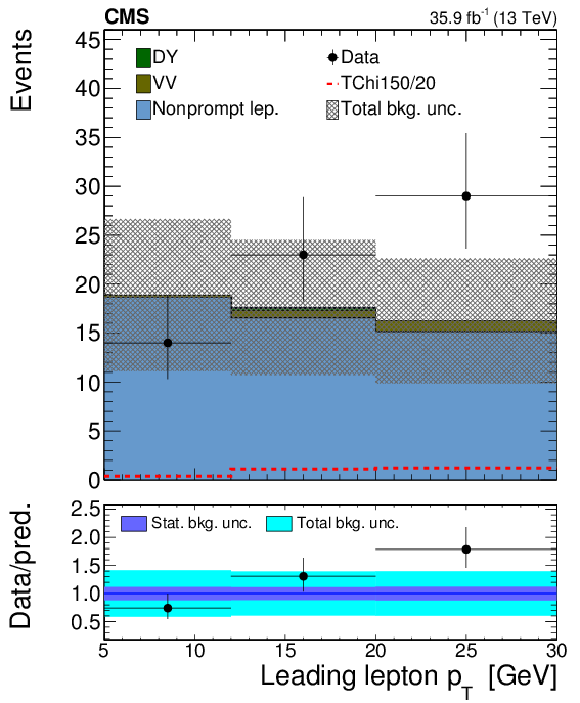
png pdf |
Figure 2:
Same-sign CR for $\tilde{\mathrm{t}} $ selection and $ {{p_{\mathrm {T}}} ^\text {miss}} > $ 200 GeV. The distribution of the leading lepton $ {p_{\mathrm {T}}} $ is used as input to the final signal extraction. A signal from neutralino-chargino ($ \tilde{\chi}^{0}_2$-$ \tilde{\chi}^{\pm}_1$) production is superimposed. |
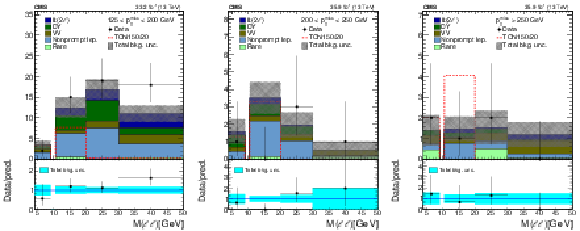
png pdf |
Figure 3:
Left: electroweakino search regions in bins of $M(\ell \ell)$ for 125 $ < {{p_{\mathrm {T}}} ^\text {miss}} < $ 200 GeV (muon only channel) for 33.2 fb$^{-1}$ ; middle: 200 $ < {{p_{\mathrm {T}}} ^\text {miss}} < $ 250 GeV (muon and electron channel) for 35.9 fb$^{-1}$ ; right: $ {{p_{\mathrm {T}}} ^\text {miss}} > $ 250 GeV (muon and electron channel) for 35.9 fb$^{-1}$. A signal from neutralino-chargino ($ \tilde{\chi}^{0}_2$-$ \tilde{\chi}^{\pm}_1$) production is superimposed. |

png pdf |
Figure 3-a:
Electroweakino search regions in bins of $M(\ell \ell)$ for 125 $ < {{p_{\mathrm {T}}} ^\text {miss}} < $ 200 GeV (muon only channel) for 33.2 fb$^{-1}$. A signal from neutralino-chargino ($ \tilde{\chi}^{0}_2$-$ \tilde{\chi}^{\pm}_1$) production is superimposed. |
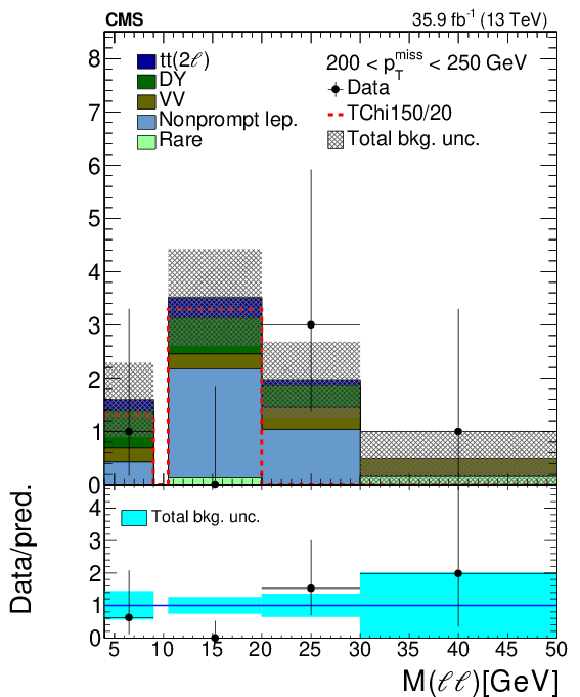
png pdf |
Figure 3-b:
Electroweakino search regions in bins of $M(\ell \ell)$ for 200 $ < {{p_{\mathrm {T}}} ^\text {miss}} < $ 250 GeV (muon and electron channel) for 35.9 fb$^{-1}$. A signal from neutralino-chargino ($ \tilde{\chi}^{0}_2$-$ \tilde{\chi}^{\pm}_1$) production is superimposed. |

png pdf |
Figure 3-c:
Electroweakino search regions in bins of $M(\ell \ell)$ for $ {{p_{\mathrm {T}}} ^\text {miss}} > $ 250 GeV (muon and electron channel) for 35.9 fb$^{-1}$. A signal from neutralino-chargino ($ \tilde{\chi}^{0}_2$-$ \tilde{\chi}^{\pm}_1$) production is superimposed. |
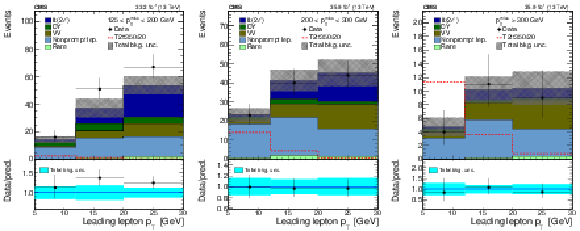
png pdf |
Figure 4:
Left: $ \tilde{\mathrm{t}} $ search regions in bins of leading lepton ${p_{\mathrm {T}}}$ for 125 $ < {{p_{\mathrm {T}}} ^\text {miss}} < $ 200 GeV (muon only channel) for 33.2 fb$^{-1}$ ; middle: 200 $ < {{p_{\mathrm {T}}} ^\text {miss}} < $ 300 GeV (muon and electron channel) for 35.9 fb$^{-1}$ ; right: $ {{p_{\mathrm {T}}} ^\text {miss}} > $ 300 GeV (muon and electron channel) for 35.9 fb$^{-1}$. A signal from $ \tilde{\mathrm{t}} $ pair production is superimposed. |

png pdf |
Figure 4-a:
$ \tilde{\mathrm{t}} $ search regions in bins of leading lepton ${p_{\mathrm {T}}}$ for 125 $ < {{p_{\mathrm {T}}} ^\text {miss}} < $ 200 GeV (muon only channel) for 33.2 fb$^{-1}$. A signal from $ \tilde{\mathrm{t}} $ pair production is superimposed. |
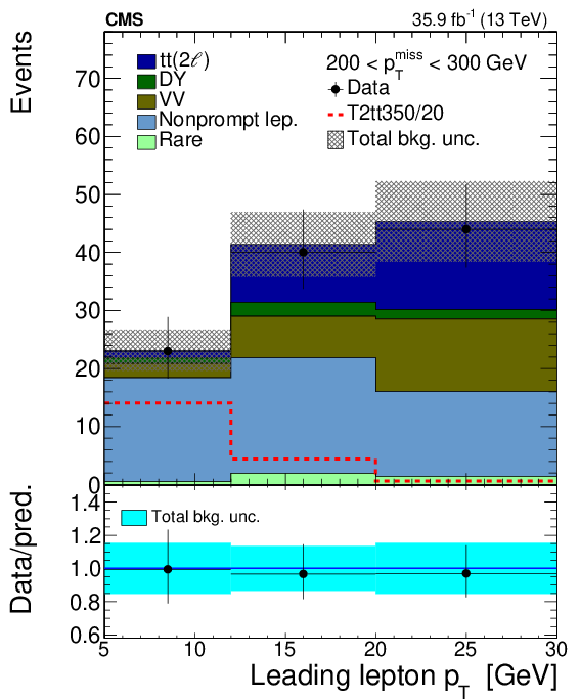
png pdf |
Figure 4-b:
$ \tilde{\mathrm{t}} $ search regions in bins of leading lepton ${p_{\mathrm {T}}}$ for 200 $ < {{p_{\mathrm {T}}} ^\text {miss}} < $ 300 GeV (muon and electron channel) for 35.9 fb$^{-1}$. A signal from $ \tilde{\mathrm{t}} $ pair production is superimposed. |
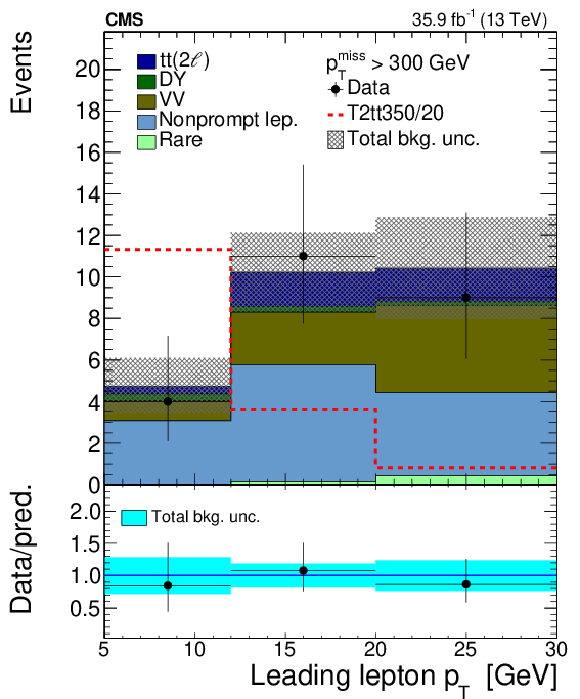
png pdf |
Figure 4-c:
$ \tilde{\mathrm{t}} $ search regions in bins of leading lepton ${p_{\mathrm {T}}}$ for $ {{p_{\mathrm {T}}} ^\text {miss}} > $ 300 GeV (muon and electron channel) for 35.9 fb$^{-1}$. A signal from $ \tilde{\mathrm{t}} $ pair production is superimposed. |

png pdf |
Figure 5:
The observed 95% CL exclusion contours (black curves) assuming the NLO+NLL cross sections, with the variations corresponding to the uncertainty in the cross section for electroweakino. The dashed (red) curves present the 95% CL expected limits with the band covering 68% of the limits in the absence of signal. Results are based on a simplified model of $ \tilde{\chi}^{0}_2 \tilde{\chi}^{\pm}_1 \to {\mathrm {Z}}^{*} {\mathrm {W}}^{*} \tilde{\chi}^{0}_1 \tilde{\chi}^{0}_1$ process with a pure wino production cross section. |
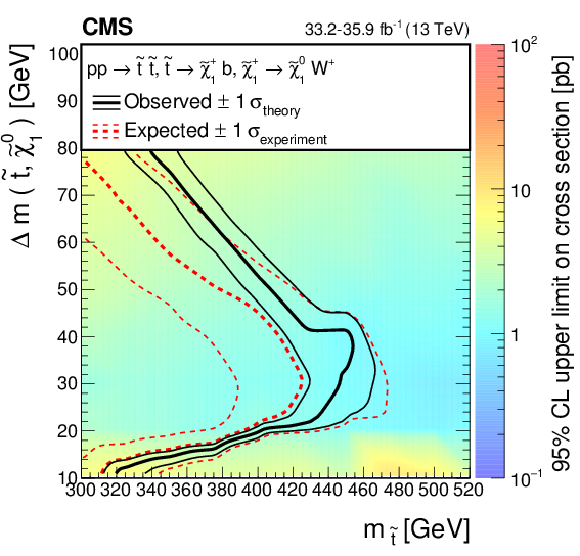
png pdf |
Figure 6:
The observed 95% CL exclusion contours (black curves) assuming the NLO+NLL cross sections, with the variations corresponding to the uncertainty in the cross section for $\tilde{\mathrm{t}} $. The dashed (red) curves present the 95% CL expected limits with the band covering 68% of the limits in the absence of signal. A simplified model of the $\tilde{\mathrm{t}} $ pair production, followed by the $ \tilde{\mathrm{t}} \to {\mathrm {b}} \tilde{\chi}^{\pm}_1$ and the subsequent $ \tilde{\chi}^{\pm}_1 \to {\mathrm {W}}^{*} \tilde{\chi}^{0}_1$ decay is used for the $\tilde{\mathrm{t}} $ search. In this latter model, the mass of the $ \tilde{\chi}^{\pm}_1$ is set to be $ (m_{\tilde{\mathrm{t}} } + m_{\tilde{\chi}^{0}_1})/2$. |
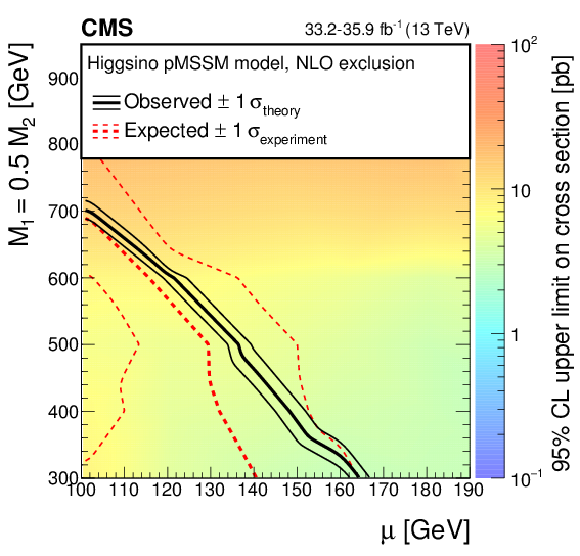
png pdf |
Figure 7:
The observed 95% CL exclusion contours (black curve) assuming the NLO cross sections, with the variations corresponding to the uncertainty in the cross sections for the higgsino pMSSM, which has been introduced in the text. The dashed (red) curves present the band covering 68% of the limits in the absence of signal. The model considers all possible production processes. |

png pdf |
Figure 8:
The observed 95% CL exclusion contours (black curves) assuming the NLO+NLL cross sections, with the variations corresponding to the uncertainty in the cross sections for the higgsino simplified models. The dashed (red) curves present the expected limits with the associated band covering 68% of the limits in the absence of signal. |
| Tables | |
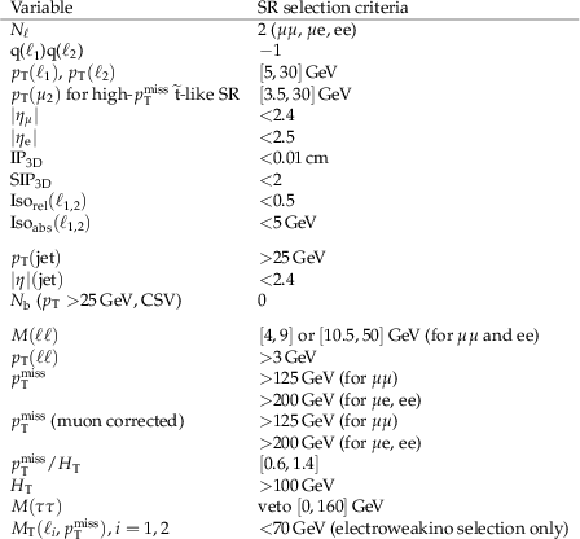
png pdf |
Table 1:
Common selection requirements for the signal regions. The subleading lepton ${p_{\mathrm {T}}}$ threshold is reduced to 3.5 GeV for muons in the high-$ {{p_{\mathrm {T}}} ^\text {miss}}$, $\tilde{\mathrm{t}} $-like signal region. |

png pdf |
Table 2:
Definition of bins in the two SRs. |

png pdf |
Table 3:
Summary of changes in selection criteria relative to Table 1 for CRs and the VV validation region (VR). |

png pdf |
Table 4:
Data and simulation yields for the DY and ${\mathrm {t}\overline {\mathrm {t}}}$ ($2\ell $) CRs, corresponding to integrated luminosities of 35.9 fb$^{-1}$ (high-$ {{p_{\mathrm {T}}} ^\text {miss}}$ region) and 33.2 fb$^{-1}$ (low-$ {{p_{\mathrm {T}}} ^\text {miss}}$ region). The SR scale factors are derived by subtracting the other processes from the observed data count, and dividing this number by the expected event yields from simulation for the process in question. The uncertainties are statistical only. |
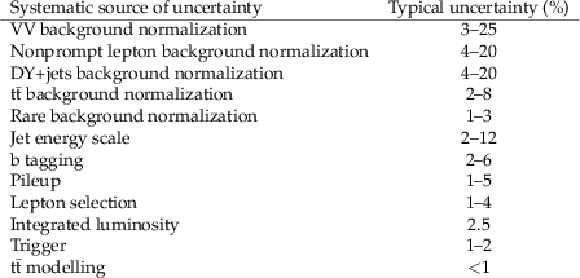
png pdf |
Table 5:
Relative uncertainties in the final predictions for each individual systematic source of uncertainty. |
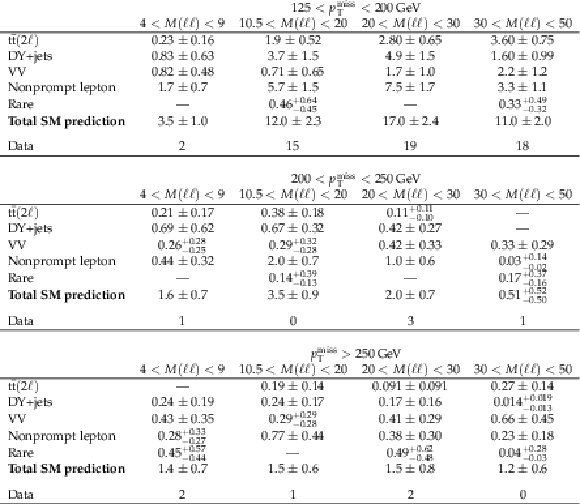
png pdf |
Table 6:
The number of events observed in the data and the result of the fit of the backgrounds to the data in the electroweakino search regions. The uncertainty indicated is determined from the fit to the 33.2 and 35.9 fb$^{-1}$ integrated luminosities. Values for the ${M(\ell \ell)}$ ranges are in GeV. Rare background event yields are omitted when they do not contribute to the SR bin. |

png pdf |
Table 7:
The number of events observed in the data and the result of the fit of the backgrounds to the data in the $ \tilde{\mathrm{t}} $ search regions. The uncertainty indicated is determined from the fit to the 33.2 and 35.9 fb$^{-1}$ integrated luminosities. Values for the $ {p_{\mathrm {T}}} (\ell _{1})$ ranges are in GeV. Rare background event yields are omitted when they do not contribute to the SR bin. |
| Summary |
| A search is presented for new physics in events with two low-momentum leptons of opposite charge and missing transverse momentum in data collected by the CMS experiment at a centre-of-mass energy of 13 TeV, corresponding to an integrated luminosity of up to 35.9 fb$^{-1}$. The data are found to be consistent with standard model expectations. The results are interpreted in the framework of supersymmetric simplified models targeting electroweakino mass-degenerate spectra and $\tilde{\mathrm{t}}$-$\tilde{\chi}^{0}_1$ mass-degenerate benchmark models. For the $\tilde{\mathrm{t}} $ chargino-mediated decay into $\mathrm{b}\mathrm{W}^{*}\tilde{\chi}^{0}_1$, top squark masses of up to 450 GeV are excluded in a simplified model for $\Delta m (\tilde{\mathrm{t}},\tilde{\chi}^{0}_1) = $ 40 GeV. The search further probes the $\tilde{\chi}^{0}_2\tilde{\chi}^{\pm}_1\to \mathrm{Z}^{*}\mathrm{W}^{*}\tilde{\chi}^{0}_1\tilde{\chi}^{0}_1$ process for mass differences ($\Delta m$) between $\tilde{\chi}^{0}_2$ and $\tilde{\chi}^{0}_1$ of less than 20 GeV. Assuming wino production cross sections, $\tilde{\chi}^{0}_2$ masses up to 230 GeV are excluded for $\Delta m$ of 20 GeV. The search is also sensitive to higgsino production; in a simplified higgsino model, $\tilde{\chi}^{0}_2$ masses up to 167 GeV are excluded for $\Delta m$ of 15 GeV, while in a higgsino pMSSM, limits in the higgsino-bino mass parameters $\mu$-$M_1$ plane are extracted. |
| Additional Figures | |

png pdf root |
Additional Figure 1:
Covariance matrix for the expected backgrounds from the predictive fit in the electroweakino search region. The definition of the SRs can be found in Table 2. |

png pdf root |
Additional Figure 2:
Covariance matrix for the expected backgrounds from the predictive fit in the electroweakino search region (text version). The definition of the SRs can be found in Table 2. |
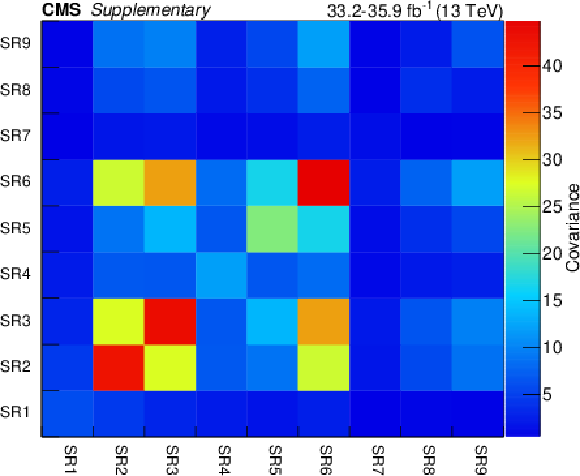
png pdf root |
Additional Figure 3:
Covariance matrix for the expected backgrounds from the predictive fit in the $\tilde{\mathrm{t}}$ search region. The definition of the SRs can be found in Table 2. |
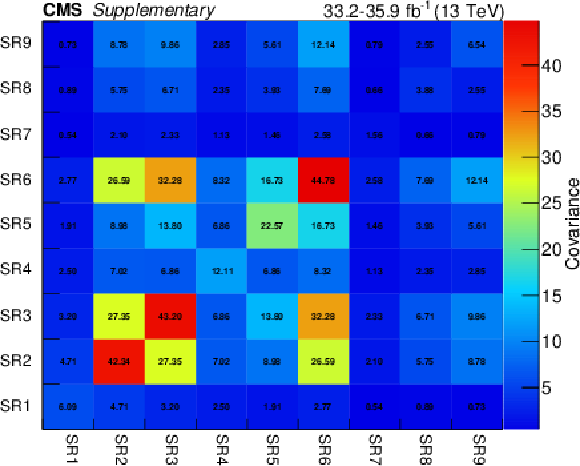
png pdf root |
Additional Figure 4:
Covariance matrix for the expected backgrounds from the predictive fit in the $\tilde{\mathrm{t}}$ search region (text version). The definition of the SRs can be found in Table 2. |
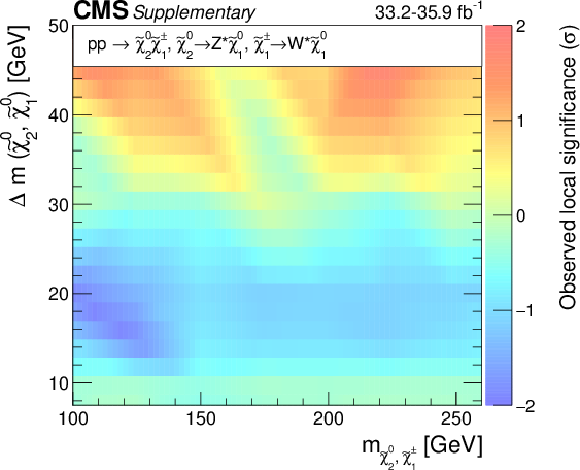
png pdf root |
Additional Figure 5:
Observed significance for the electroweakino simplified model using pure wino production cross section. |
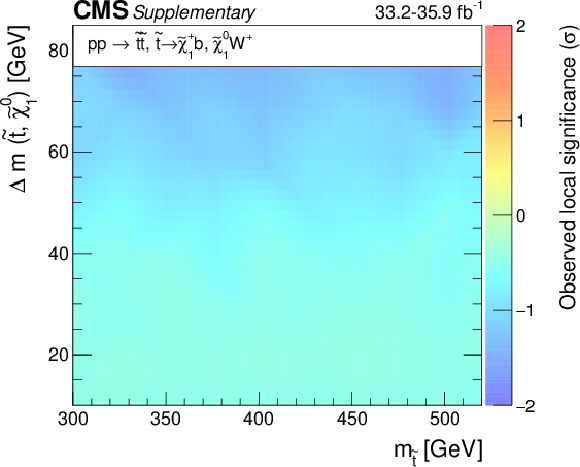
png pdf root |
Additional Figure 6:
Observed significance for the ${\tilde{\mathrm {t}}}$ pair production simplified model. |

png pdf root |
Additional Figure 7:
Observed significance for the higgsino pMSSM. |
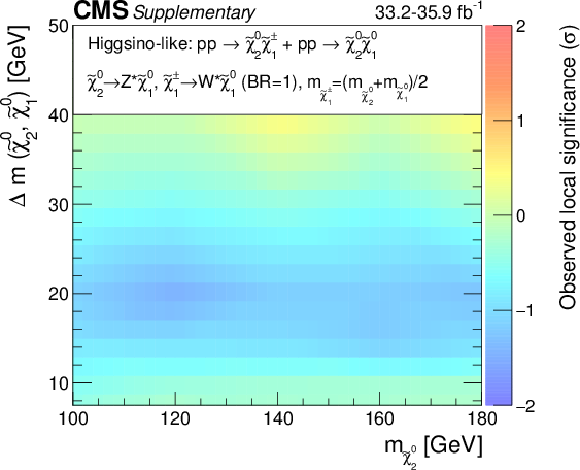
png pdf root |
Additional Figure 8:
Observed significance for the higgsino simplified model. |
| Additional Tables | |
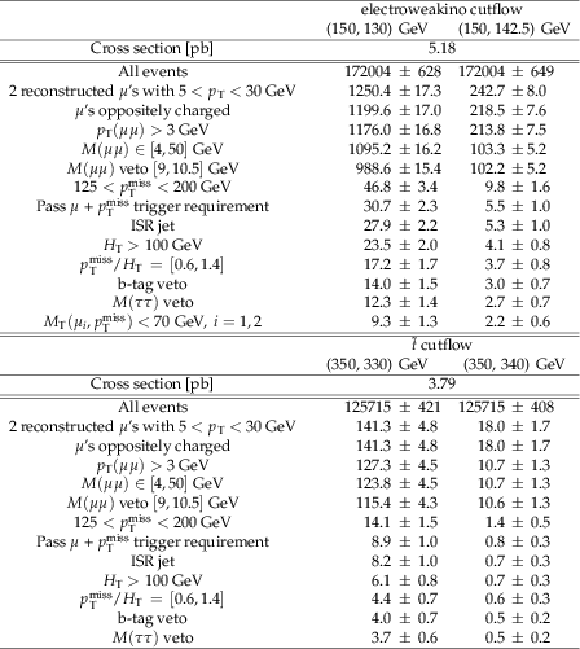
png pdf |
Additional Table 1:
Signal cutflow for the low-$ {{p_{\mathrm {T}}} ^\text {miss}}$ search regions corresponding to 33.2 fb$^{-1}$ of integrated luminosity. The cutflow numbers are given for the four signal benchmark points and are represented as the mass pair ($\tilde{\chi}_2^{0}$,$\tilde{\chi}_1^{0}$) or ($\tilde{\mathrm{t}}$,$\tilde{\chi}_1^{0}$). The yields are normalized to the theoretical cross sections. Uncertainties are statistical only. |
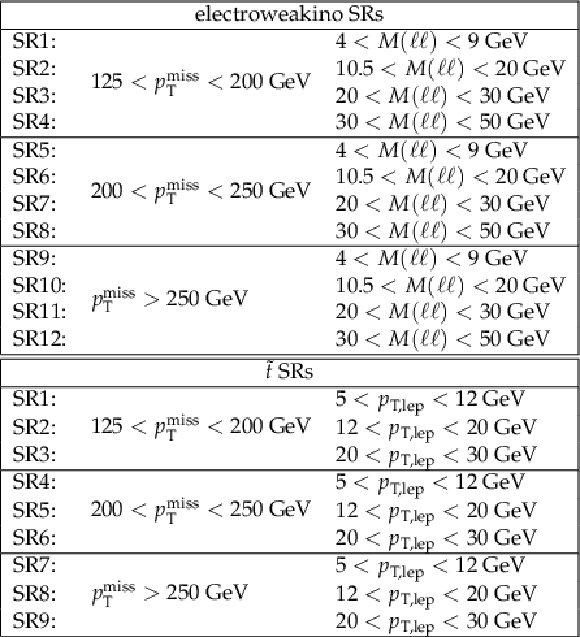
png pdf |
Additional Table 2:
SR keys used for covariance matrices. |
| References | ||||
| 1 | J. Wess and B. Zumino | Supergauge transformations in four dimensions | NPB 70 (1974) 39 | |
| 2 | H. P. Nilles | Supersymmetry, supergravity and particle physics | PR 110 (1984) 1 | |
| 3 | H. E. Haber and G. L. Kane | The search for supersymmetry: Probing physics beyond the standard model | PR 117 (1985) 75 | |
| 4 | R. Barbieri, S. Ferrara, and C. A. Savoy | Gauge models with spontaneously broken local supersymmetry | PLB 119 (1982) 343 | |
| 5 | S. Dawson, E. Eichten, and C. Quigg | Search for supersymmetric particles in hadron-hadron collisions | PRD 31 (1985) 1581 | |
| 6 | R. Barbieri and G. Giudice | Upper bounds on supersymmetric particle masses | NPB 306 (1988) 63 | |
| 7 | E. Witten | Dynamical breaking of supersymmetry | NPB 188 (1981) 513 | |
| 8 | S. Dimopoulos and H. Georgi | Softly broken supersymmetry and SU(5) | NPB 193 (1981) 150 | |
| 9 | G. R. Farrar and P. Fayet | Phenomenology of the production, decay, and detection of new hadronic states associated with supersymmetry | PLB 76 (1978) 575 | |
| 10 | B. de Carlos and J. Casas | One-loop analysis of the electroweak breaking in supersymmetric models and the fine-tuning problem | PLB 309 (1993) 320 | hep-ph/9303291 |
| 11 | M. Dine, W. Fischler, and M. Srednicki | Supersymmetric technicolor | NPB 189 (1981) 575 | |
| 12 | S. Dimopoulos and S. Raby | Supercolor | NPB 192 (1981) 353 | |
| 13 | N. Sakai | Naturalness in supersymmetric GUTS | Z. Phys. C 11 (1981) 153 | |
| 14 | R. K. Kaul and P. Majumdar | Cancellation of quadratically divergent mass corrections in globally supersymmetric spontaneously broken gauge theories | NPB 199 (1982) 36 | |
| 15 | H. Baer, A. Mustafayev, and X. Tata | Monojet plus soft dilepton signal from light higgsino pair production at LHC14 | PRD 90 (2014) 115007 | 1409.7058 |
| 16 | G. F. Giudice, T. Han, K. Wang, and L.-T. Wang | Nearly degenerate gauginos and dark matter at the LHC | PRC 81 (2010) 115011 | 1004.4902 |
| 17 | C. Han et al. | Probing light higgsinos in natural SUSY from monojet signals at the LHC | JHEP 02 (2014) 049 | 1310.4274 |
| 18 | Z. Han, G. D. Kribs, A. Martin, and A. Menon | Hunting quasidegenerate Higgsinos | PRD 89 (2014) 075007 | 1401.1235 |
| 19 | ALEPH Collaboration | Search for charginos nearly mass degenerate with the lightest neutralino in $\mathrm{ e^{+} e^{-} }$ collisions at center-of-mass energies up to 209 GeV | PLB 533 (2002) 223 | hep-ex/0203020 |
| 20 | DELPHI Collaboration | Searches for supersymmetric particles in $ \mathrm{ e^{+} e^{-} }$ collisions up to 208 GeV and interpretation of the results within the MSSM | EPJC 31 (2003) 421 | hep-ex/0311019 |
| 21 | P. Schwaller and J. Zurita | Compressed electroweakino spectra at the LHC | JHEP 03 (2014) 060 | 1312.7350 |
| 22 | R. Grober, M. M. Muhlleitner, E. Popenda, and A. Wlotzka | Light stop decays: implications for LHC searches | EPJC 75 (2015) 420 | 1408.4662 |
| 23 | C. Bal\'azs, M. Carena, and C. E. M. Wagner | Dark matter, light stops and electroweak baryogenesis | PRD 70 (2004) 015007 | hep-ph/0403224 |
| 24 | ATLAS Collaboration | Search for electroweak production of supersymmetric states in scenarios with compressed mass spectra at $ \sqrt{s}= $ 13 TeV with the ATLAS detector | 1712.08119 | |
| 25 | ATLAS Collaboration | Search for new phenomena in final states with an energetic jet and large missing transverse momentum in pp collisions at $ \sqrt{s}= $ 8 TeV with the ATLAS detector | EPJC 75 (2015) 299 | 1502.01518 |
| 26 | CMS Collaboration | Search for dark matter, extra dimensions, and unparticles in monojet events in proton-proton collisions at $ \sqrt{s} = $ 8 TeV | EPJC 75 (2015) 235 | CMS-EXO-12-048 1408.3583 |
| 27 | CMS Collaboration | Search for dark matter and supersymmetry with a compressed mass spectrum in the vector boson fusion topology in proton-proton collisions at $ \sqrt{s} = $ 8 TeV | PRL 118 (2017) 021802 | CMS-SUS-14-019 1605.09305 |
| 28 | CMS Collaboration | Search for supersymmetry in events with soft leptons, low jet multiplicity, and missing transverse energy in proton-proton collisions at $ \sqrt{s} = $ 8 TeV | PLB 759 (2016) 9 | CMS-SUS-14-021 1512.08002 |
| 29 | CMS Collaboration | Performance of electron reconstruction and selection with the CMS detector in proton-proton collisions at $ \sqrt{s} = $ 8 TeV | JINST 10 (2015) P06005 | CMS-EGM-13-001 1502.02701 |
| 30 | CMS Collaboration | Performance of CMS muon reconstruction in $ {\mathrm{p}}{\mathrm{p}} $ collision events at $ \sqrt{s} = $ 7 TeV | JINST 7 (2012) P10002 | CMS-MUO-10-004 1206.4071 |
| 31 | CMS Collaboration | The CMS trigger system | JINST 12 (2017) P01020 | CMS-TRG-12-001 1609.02366 |
| 32 | CMS Collaboration | The CMS Experiment at the CERN LHC | JINST 3 (2008) S08004 | CMS-00-001 |
| 33 | J. Alwall et al. | The automated computation of tree-level and next-to-leading order differential cross sections, and their matching to parton shower simulations | JHEP 07 (2014) 079 | 1405.0301 |
| 34 | R. Frederix and S. Frixione | Merging meets matching in MC@NLO | JHEP 12 (2012) 061 | 1209.6215 |
| 35 | J. Alwall et al. | Comparative study of various algorithms for the merging of parton showers and matrix elements in hadronic collisions | EPJC 53 (2008) 473 | 0706.2569 |
| 36 | P. Nason | A new method for combining NLO QCD with shower Monte Carlo algorithms | JHEP 11 (2004) 040 | hep-ph/0409146 |
| 37 | S. Frixione, P. Nason, and C. Oleari | Matching NLO QCD computations with parton shower simulations: the POWHEG method | JHEP 11 (2007) 070 | 0709.2092 |
| 38 | S. Alioli, P. Nason, C. Oleari, and E. Re | A general framework for implementing NLO calculations in shower Monte Carlo programs: the POWHEG BOX | JHEP 06 (2010) 043 | 1002.2581 |
| 39 | T. Melia, P. Nason, R. Rontsch, and G. Zanderighi | $ \mathrm{W}^+\mathrm{W}^- $, $ \mathrm{W}\mathrm{Z} $ and $ \mathrm{Z}\mathrm{Z} $ production in the POWHEG BOX | JHEP 11 (2011) 078 | 1107.5051 |
| 40 | P. Nason and G. Zanderighi | $ \mathrm{W}^+ \mathrm{W}^- $, $ \mathrm{W}\mathrm{Z} $ and $ \mathrm{Z}\mathrm{Z} $ production in the POWHEG-BOX-V2 | EPJC 74 (2014) 2702 | 1311.1365 |
| 41 | E. Re | Single-top $ Wt $-channel production matched with parton showers using the POWHEG method | EPJC 71 (2011) 1547 | 1009.2450 |
| 42 | NNPDF Collaboration | Parton distributions for the LHC Run II | JHEP 04 (2015) 040 | 1410.8849 |
| 43 | T. Sjostrand et al. | An introduction to PYTHIA 8.2 | CPC 191 (2015) 159 | 1410.3012 |
| 44 | P. Skands, S. Carrazza, and J. Rojo | Tuning PYTHIA 8.1: the Monash 2013 tune | EPJC 74 (2014) 3024 | 1404.5630 |
| 45 | CMS Collaboration | Event generator tunes obtained from underlying event and multiparton scattering measurements | EPJC 76 (2016) 155 | CMS-GEN-14-001 1512.00815 |
| 46 | GEANT4 Collaboration | GEANT4---a simulation toolkit | NIMA 506 (2003) 250 | |
| 47 | CMS Collaboration | The fast simulation of the CMS detector at LHC | J. Phys. Conf. Ser. 331 (2011) 032049 | |
| 48 | W. Beenakker et al. | Production of charginos, neutralinos, and sleptons at hadron colliders | PRL 83 (1999) 3780 | hep-ph/9906298 |
| 49 | B. Fuks, M. Klasen, D. R. Lamprea, and M. Rothering | Gaugino production in proton-proton collisions at a center-of-mass energy of 8 TeV | JHEP 10 (2012) 081 | 1207.2159 |
| 50 | B. Fuks, M. Klasen, D. R. Lamprea, and M. Rothering | Precision predictions for electroweak superpartner production at hadron colliders with Resummino | EPJC 73 (2013) 2480 | 1304.0790 |
| 51 | MSSM Working Group | The minimal supersymmetric standard model: Group summary report | hep-ph/9901246 | |
| 52 | J. Alwall et al. | MadGraph5: going beyond | JHEP 06 (2011) 128 | 1106.0522 |
| 53 | W. Beenakker, R. Hopker, and M. Spira | PROSPINO: A program for the production of supersymmetric particles in next-to-leading order QCD | hep-ph/9611232 | |
| 54 | A. Djouadi, J.-L. Kneur, and G. Moultaka | SuSpect: A Fortran code for the supersymmetric and Higgs particle spectrum in the MSSM | CPC 176 (2007) 426 | hep-ph/0211331 |
| 55 | M. Muhlleitner, A. Djouadi, and Y. Mambrini | SDECAY: A Fortran code for the decays of the supersymmetric particles in the MSSM | CPC 168 (2005) 46 | hep-ph/0311167 |
| 56 | A. Djouadi, J. Kalinowski, and M. Spira | HDECAY: A program for Higgs boson decays in the standard model and its supersymmetric extension | CPC 108 (1998) 56 | hep-ph/9704448 |
| 57 | M. M. Muhlleitner, A. Djouadi, and M. Spira | Decays of supersymmetric particles: The Program SUSY-HIT | in Physics at LHC. Proceedings, 3rd Conference, volume 38, p. 635 Cracow, Poland, July, 2006 Acta Phys. Polon. B 38 (2007) 635 | hep-ph/0609292 |
| 58 | P. Z. Skands et al. | SUSY Les Houches accord: Interfacing SUSY spectrum calculators, decay packages, and event generators | JHEP 07 (2004) 036 | hep-ph/0311123 |
| 59 | CMS Collaboration | Particle-flow reconstruction and global event description with the CMS detector | JINST 12 (2017) P10003 | CMS-PRF-14-001 1706.04965 |
| 60 | M. Cacciari, G. P. Salam, and G. Soyez | The anti-$ k_t $ jet clustering algorithm | JHEP 04 (2008) 063 | 0802.1189 |
| 61 | M. Cacciari, G. P. Salam, and G. Soyez | FastJet user manual | EPJC 72 (2012) 1896 | 1111.6097 |
| 62 | CMS Collaboration | Measurements of properties of the Higgs boson decaying into the four-lepton final state in pp collisions at $ \sqrt{s}= $ 13 TeV | JHEP 11 (2017) 047 | CMS-HIG-16-041 1706.09936 |
| 63 | CMS Collaboration | Description and performance of track and primary-vertex reconstruction with the CMS tracker | JINST 9 (2014) P10009 | CMS-TRK-11-001 1405.6569 |
| 64 | CMS Collaboration | Determination of jet energy calibration and transverse momentum resolution in CMS | JINST 6 (2011) P11002 | CMS-JME-10-011 1107.4277 |
| 65 | M. Cacciari and G. P. Salam | Pileup subtraction using jet areas | PLB 659 (2008) 119 | 0707.1378 |
| 66 | CMS Collaboration | Jet energy scale and resolution in the CMS experiment in pp collisions at 8 TeV | JINST 12 (2017) P02014 | CMS-JME-13-004 1607.03663 |
| 67 | CMS Collaboration | Identification of heavy-flavour jets with the CMS detector in pp collisions at 13 TeV | Submitted to \it JINST | CMS-BTV-16-002 1712.07158 |
| 68 | CMS Collaboration | Identification of b-quark jets with the CMS experiment | JINST 8 (2013) P04013 | CMS-BTV-12-001 1211.4462 |
| 69 | CMS Collaboration | Performance of missing energy reconstruction in 13 TeV pp collision data using the CMS detector | CMS-PAS-JME-16-004 | CMS-PAS-JME-16-004 |
| 70 | CMS Collaboration | Search for new physics with same-sign isolated dilepton events with jets and missing transverse energy at the LHC | JHEP 06 (2011) 077 | CMS-SUS-10-004 1104.3168 |
| 71 | ATLAS Collaboration | Measurement of spin correlation in top-antitop quark events and search for top squark pair production in $ {\mathrm{p}}{\mathrm{p}} $ collisions at $ \sqrt{s} = $ 8 TeV using the ATLAS detector | PRL 114 (2015) 142001 | 1412.4742 |
| 72 | CMS Collaboration | Measurements of $ \mathrm{t\bar{t}} $ spin correlations and top quark polarization using dilepton final states in pp collisions at $ \sqrt{s} = $ 8 TeV | PRD 93 (2016) 052007 | CMS-TOP-14-023 1601.01107 |
| 73 | CMS Collaboration | CMS luminosity measurement for the 2016 data taking period | CMS-PAS-LUM-15-001 | CMS-PAS-LUM-15-001 |
| 74 | G. Cowan, K. Cranmer, E. Gross, and O. Vitells | Asymptotic formulae for likelihood-based tests of new physics | EPJC 71 (2011) 1554 | 1007.1727 |
| 75 | T. Junk | Confidence level computation for combining searches with small statistics | Nucl. Instr. Meth. A 434 (1999) 435 | hep-ex/9902006 |
| 76 | A. L. Read | Presentation of search results: the $ {CL}_s $ technique | JPG 28 (2002) 2693 | |
| 77 | B. Fuks, M. Klasen, S. Schmiemann, and M. Sunder | Realistic simplified gaugino-higgsino models in the MSSM | Submitted to EPJC | 1710.09941 |

|
Compact Muon Solenoid LHC, CERN |

|

|

|

|

|

|